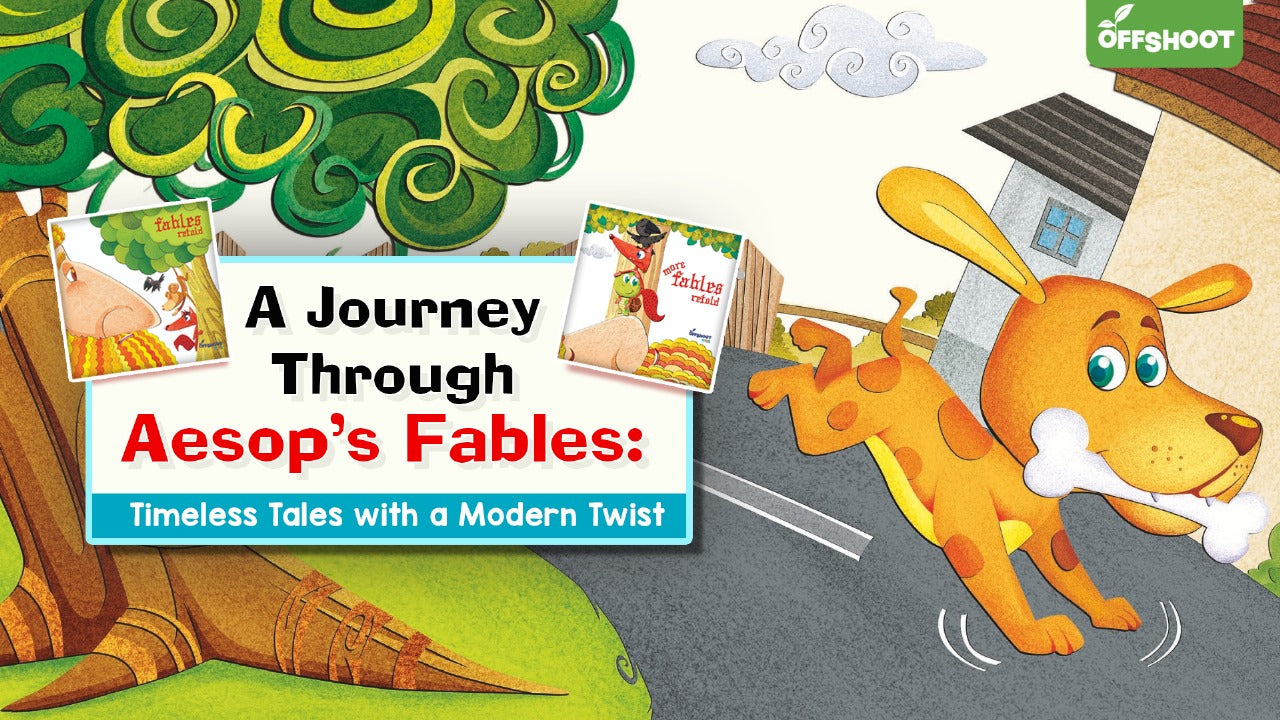
A Journey Through Aesop's Fables:
| Offshoot Books
Timeless Tales with a Modern Twist
We've all heard stories like "The Hare and the Tortoise," "The Ant and the Grasshopper," and "The Boy Who Cried Wolf." These tales have been passed down through generations, but have you ever wondered where they came from? How did these stories become so universally known and cherished? What makes them so enduring that they are still told to this day? Well, these tales are actually called fables. They were composed in ancient Greece by a storyteller called Aesop.
Before diving deeper into Aesop's Fables, let's understand what fables are.
What are Fables?
Fables are short stories that typically feature animals as characters and convey a moral lesson. These tales are designed to teach ethical or practical lessons through the actions and outcomes experienced by the characters. Unlike other forms of storytelling, fables often personify animals, giving them human traits and abilities to reflect human behaviours.
Now, let’s shift gears and move to ancient Greece to trace the origins of our favourite fables.
The Origin of Aesop's Fables
Aesop is believed to have lived in ancient Greece around 620-564 BCE. Despite the lack of solid historical evidence about Aesop's life, his fables have transcended time and geography, capturing the imaginations of both children and adults. The earliest references to Aesop and his tales come from ancient Greek sources.

According to legend, Aesop was born a slave but gained his freedom through his wit and storytelling abilities. His fables were initially passed down orally before being written down and compiled by various authors over the centuries. These stories were used as educational tools, teaching moral lessons in a simple and engaging way. Aesop's ability to convey profound truths through the actions of animals and mythical creatures made his fables accessible and relatable to people of all ages.
Some Common Aesop's Fables
The Hare and the Tortoise: This fable teaches us that "slow and steady wins the race." The overconfident hare learns a lesson in humility when the slow-moving tortoise beats him in a race. The story emphasises the importance of perseverance and not underestimating others based on appearances.

Source: Fables Retold/Offshoot Books
The Ant and the Grasshopper: Highlighting the value of hard work and planning for the future, this story contrasts the industrious ant with the carefree grasshopper. While the ant diligently prepares for winter, the grasshopper spends his time singing and playing. When winter arrives, the grasshopper finds himself without food and shelter, illustrating the consequences of procrastination and the benefits of foresight.

Source: Fables Retold/Offshoot Books
The Lion and the Mouse: After a lion spares a mouse's life, the mouse promises to repay the favour. Later, when the lion is caught in a hunter's net, the mouse gnaws through the ropes and frees him. This fable highlights the importance of kindness and how even the smallest act of generosity can make a significant impact.

Source: Fables Retold/Offshoot Books
Common Themes in Aesop's Fables
Aesop's fables are rich with themes that reflect human nature and social behaviours. Some recurring themes include:
Honesty: Fables like "The Boy Who Cried Wolf" stress the importance of truthfulness, highlighting honesty as essential for trust and credibility in relationships and society.
Perseverance: Stories such as "The Hare and the Tortoise" celebrate persistence and determination, encouraging readers to stay committed to their goals despite obstacles.
Wisdom: Fables often depict wise characters who solve problems or avoid danger, as in "The Fox and the Crow," portraying wisdom as a key trait for navigating challenges.
Kindness and Generosity: Tales like "The Lion and the Mouse" show the value of kindness and how even small acts of generosity can foster respect and cooperation.
Humility: Fables like "The Fox and the Grapes" illustrate the pitfalls of arrogance and the importance of staying grounded and realistic in one's ambitions.
Why Should You Read Aesop's Fables?
Aesop's fables are more than just entertaining stories; they are timeless lessons that offer valuable insights into human behaviour and morality. Reading these fables can:
Enhance Moral Understanding: The clear moral lessons in each story can help readers of all ages reflect on their values and behaviours. By presenting ethical dilemmas and their resolutions, fables encourage readers to consider the consequences of their actions and make thoughtful choices.
Encourage Critical Thinking: The scenarios presented in fables often involve problem-solving and decision-making, encouraging readers to think critically about their actions. By analysing the motivations and outcomes of the characters, readers can develop their reasoning and judgement skills.
Provide Cultural Insight: These ancient stories offer a glimpse into the cultural and social values of the past, enriching our understanding of history. Aesop's fables provide a window into the beliefs and norms of ancient Greece, highlighting universal themes that continue to resonate with contemporary audiences.
Foster Imagination and Creativity: The use of animals and fantastical elements in fables stimulates the imagination, making the stories engaging and memorable. This imaginative approach helps readers, especially children, develop their creativity and appreciation for storytelling.
A Fresh Take on Timeless Tales
Even in today's fast-paced world, Aesop's fables hold significant value. At Offshoot Books, we've given these classic stories a fresh touch in our "Fables Retold" series. What would Aesop say to the world today? Would he tell the same old fables or offer a new twist to relate to Gen Z readers? We believe he would adapt his stories to the times, and so have we.

Leave a comment
Your email address will not be published.